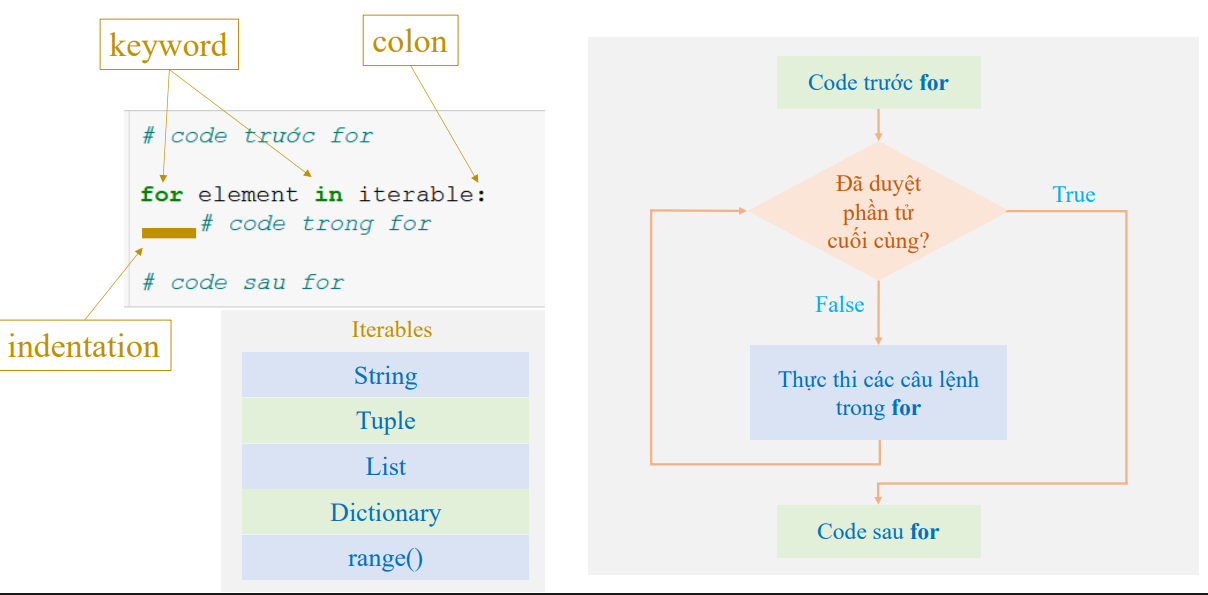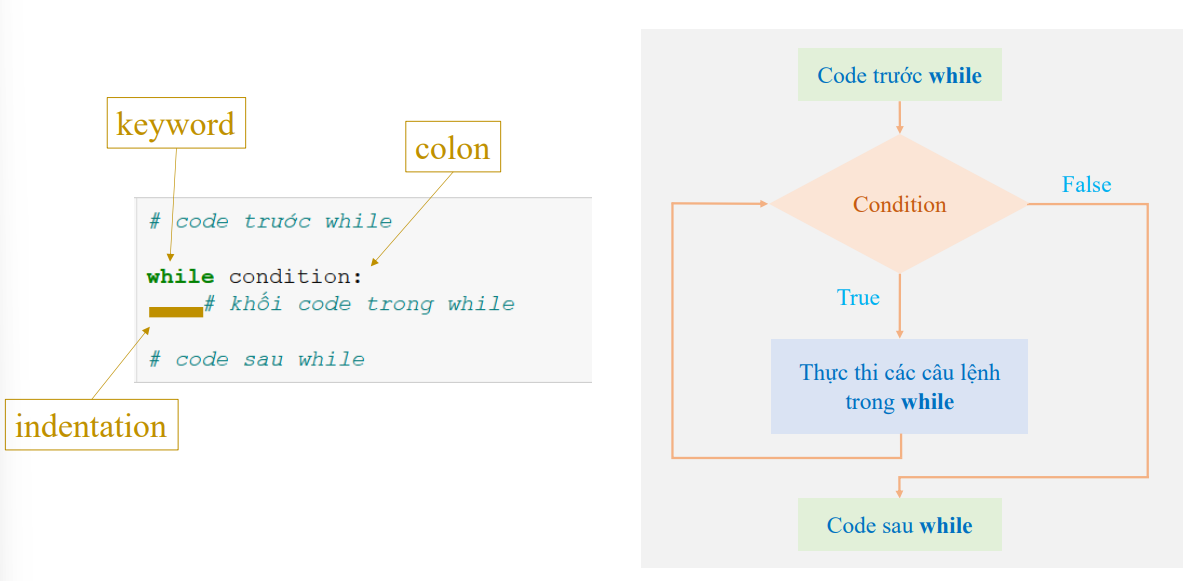Introduction
In programming, we often need to repeat certain actions multiple times — for example, printing 10 similar lines. To handle these repetitive tasks efficiently, we use loops. Python supports two main types of loops:
for loop– used to iterate over a sequence (like a list, range, tuple, etc.)while loop– repeats as long as a condition is true
FOR Loop
The for loop is used to iterate over each element in a list, string, tuple, dictionary, or any iterable object.

Breakdown of components:
- Keyword: Marks the start of the
forloop. It tells Python you want to iterate over something. - Colon: Indicates the end of the loop header and the beginning of the loop body.
- Indentation: Python uses indentation (usually 4 spaces or 1 tab) to define the block of code inside the loop
- element: A variable that represents each element from the
iterable. On each iteration, it takes the next value. iterable: Any iterable object (like a list, string, tuple, or range) that provides the elements for the loop.
The break statement is used to terminate the loop prematurely when a specific condition is met. The continue statement is used to skip the rest of the code inside the loop for the current iteration and jump to the next iteration.
Examples
# Example 1: Loop through a string
word = "Python"
for i in word:
print(i)
# Output:
# P
# y
# t
# h
# o
# n
# Example 2: Loop through a list
fruits = ["Apple", "Orange", "Banana"]
for fruit in fruits:
print(fruit)
# Output:
# Apple
# Orange
# Banana
# Example 3: Loop through a sequence of numbers using range(begin, end, step)
# Explanation:
# - begin: starting number (inclusive)
# - end: ending number (exclusive)
# - step: step size between numbers (default is 1)
for i in range(2, 10, 2):
print(i)
# Output:
# 2
# 4
# 6
# 8
- When you call
range(stop), passing only one argument:stopis the ending value (exclusive).- The default begin is
0. - The default step is
1.
- When you call
range(start, stop), passing two arguments:startis the starting value (inclusive).stopis the ending value (exclusive).- The default step is still
1.
- When you call
range(start, stop, step), passing three arguments:startis the starting value.stopis the ending value.stepis the step size (can be positive or negative).
# Only one argument: range(stop)
print("range(5):")
for i in range(5):
print(i)
# Output:
# 0
# 1
# 2
# 3
# 4
# Two arguments: range(start, stop)
print("\nrange(2, 6):")
for i in range(2, 6):
print(i)
# Output:
# 2
# 3
# 4
# 5
# Three arguments: range(start, stop, step)
print("\nrange(1, 10, 3):")
for i in range(1, 10, 3):
print(i)
# Output:
# 1
# 4
# 7
# Negative step example: counting backwards
print("\nrange(10, 0, -2):")
for i in range(10, 0, -2):
print(i)
# Output:
# 10
# 8
# 6
# 4
# 2Using break and continue in the loop
print("Example with break:")
for i in range(1, 10):
if i == 5:
break
print(i)
# Output:
# Example with break:
# 1
# 2
# 3
# 4
print("\nExample with continue:")
for i in range(1, 6):
if i == 3:
continue
print(i)
# Output:
# Example with continue:
# 1
# 2
# 4
# 5WHILE Loop
 Breakdown of components:
Breakdown of components:
-
Keyword (
while):Marks the beginning of the loop. It tells Python to repeatedly execute the loop body as long as the condition is
True. -
Condition:
A boolean expression that is evaluated before each iteration.
If the condition is
True, the loop continues; ifFalse, the loop stops. -
Colon (
:):Indicates the end of the loop header and the start of the loop body.
It’s required to define the structure of the loop.
-
Indentation:
Defines the block of code that belongs to the loop body.
Python uses indentation (usually 4 spaces) to determine which statements are inside the loop.
The break statement is used to terminate the loop prematurely when a specific condition is met. The continue statement is used to skip the rest of the code inside the loop for the current iteration and jump to the next iteration.
Examples
i = 0
while i < 5: # Loop continues while i < 5
print("i =", i)
i += 1 # When i becomes 5, the condition is False and the loop stops
# Output:
# i = 0
# i = 1
# i = 2
# i = 3
# i = 4
#Using break to exit the loop
i = 0
while True: # Infinite loop
print("i =", i)
if i == 3:
break # Breaks the loop when i == 3
i += 1
# Output:
# i = 0
# i = 1
# i = 2
# i = 3
#Using continue to skip an iteration
i = 0
while i < 5:
i += 1
if i == 3:
continue # Skips the rest of the loop when i == 3
print("i =", i)
# Output:
# i = 1
# i = 2
# i = 4
# i = 5
When to Use for vs. while
| Situation | Use This Loop |
|---|---|
| You know how many times to loop / have a sequence | for |
| You want to loop until a condition is met | while |
Back Matter
Source
- based_on: Week 1 Module 1